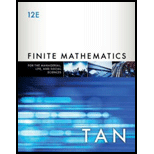
Concept explainers
In Exercises 1-5, find a logic statement corresponding to the network. Determine the conditions under which current will flow from

To find:
The logic statement corresponding to the network and write the conditions under which current can be flow from
Answer to Problem 1E
Solution:
The logic statement corresponding to the network is
Explanation of Solution
Given:
The logic statement is

Figure(1)
Approach:
When the two circuits
When the two circuits
Calculation:
The current will pass from point
1.
2.
3. either
Therefore, the logic statement corresponding to the network is
Conclusion:
Hence, the logic statement corresponding to the network is
Want to see more full solutions like this?
Chapter A Solutions
Finite Mathematics for the Managerial, Life, and Social Sciences
Additional Math Textbook Solutions
Discrete Mathematics with Graph Theory (Classic Version) (3rd Edition) (Pearson Modern Classics for Advanced Mathematics Series)
Using & Understanding Mathematics: A Quantitative Reasoning Approach (7th Edition)
Finite Mathematics with Applications In the Management, Natural, and Social Sciences (12th Edition)
Math in Our World
Excursions in Modern Mathematics (9th Edition)
Finite Mathematics for Business, Economics, Life Sciences and Social Sciences
 Linear Algebra: A Modern IntroductionAlgebraISBN:9781285463247Author:David PoolePublisher:Cengage Learning
Linear Algebra: A Modern IntroductionAlgebraISBN:9781285463247Author:David PoolePublisher:Cengage Learning
